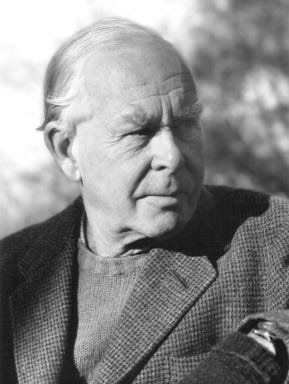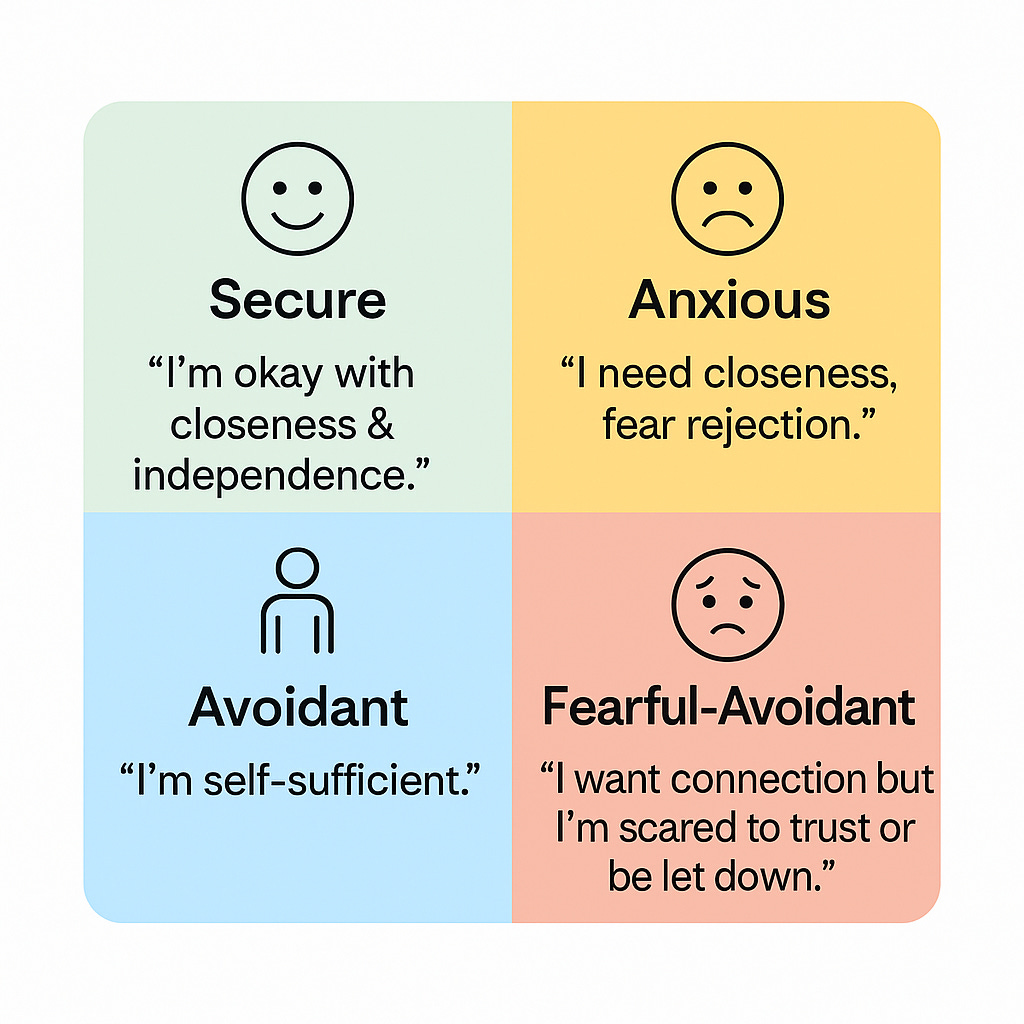Attachment Theory Part 1: Attachment Theory 101 -- What It Is and Why It Matters At Work
From Secure to Fearful-Avoidant, understanding these four styles can transform feedback, trust, and collaboration.
What is Attachment Theory?
Initially, attachment theory was used in developmental psychology and clinical settings to understand child development, caregiving, and later, how early experiences influenced adult relationships and mental health.
Attachment Theory has become a buzzword (or buzzphrase?) in the self-help world, but at its core, it’s a powerful framework for understanding relationships.
Here’s what it really means.
History of Attachment Theory and How It’s Morphed Today
Attachment Theory emerged in the mid-20th century, introduced by psychiatrist John Bowlby and later shaped by psychologist Mary Ainsworth. It revealed how early bonds with caregivers shape our sense of security, exploration, and trust long beyond childhood.
While originally focused on children and caregivers, attachment theory now informs clinical therapy, parenting approaches, and even workplace dynamics. Understanding our styles has shown how secure attachment predicts better emotional regulation, stable relationships, and resilience, while insecure styles help explain struggles with anxiety, avoidance, inconsistency, and reactivity.

In the workplace, attachment styles translate into our relationship operating system, influencing how we take feedback, process stress, and interact with colleagues day-to-day.
The Four Styles
Secure
Comfortable with intimacy and autonomy. Trusting of self and others. They can balance closeness and independence with ease, making them reliable and emotionally available partners or colleagues.Anxious (Preoccupied)
Craves closeness, fears rejection, and is highly sensitive to cues of abandonment. They often seek reassurance and can become preoccupied with relationships, sometimes overanalyzing small signals.Avoidant (Dismissive)
Prefers independence and suppresses needs for closeness. They often appear confident and self-sufficient but may struggle to express vulnerability or rely on others.Fearful-Avoidant (Disorganized)
Desires connection but fears it, oscillating between approach and withdrawal. They can be deeply conflicted, wanting closeness yet pushing others away when intimacy feels threatening.
How Styles Show Up at Work
1. Secure
Signature Moves: They seek feedback, give support, and manage conflict with grace. Research shows they are more likely to perform well, complete tasks reliably, build strong bonds with colleagues, and cultivate trust across teams.
Superpower: Trust-builder; emotionally resilient.
Growth Edges: Staying grounded even when others are reactive, inconsistent, or less secure. (Different from avoidant — this is about tolerating other people’s reactivity or inconsistency rather than withdrawing.)
2. Anxious / Preoccupied
Signature Moves: Frequent check-ins, over-apologizing, over-communicating, monitoring tone or response times, and sometimes taking silence as rejection.
Superpower: Hyper-vigilant collaborator, attuned to risks and highly empathetic to others’ needs; can be an early warning system for relationship fractures.
Growth Edges: Learning to tolerate ambiguity, being okay with silence or “not knowing,” and avoiding burnout from emotional over-investment.
3. Avoidant / Dismissive
Signature Moves: Prefers asynchronous communication, avoids small talk or “extra” meetings, seeks autonomy, and keeps emotional distance in professional settings. May disengage quickly when conflict arises.
Superpower: Independent self-starter, efficient under pressure, calm in chaos, and able to detach enough to make tough decisions.
Growth Edges: Building trust through transparency; leaning into conflict conversations without retreating or coming across as detached/aloof.
4. Fearful-Avoidant / Disorganized
Signature Moves: Swings between seeking closeness and withdrawal, reacts unpredictably to perceived threats, may misinterpret intent in feedback or collaboration, and can shift suddenly between being highly engaged and withdrawn.
Superpower: Deep empathy when they feel safe; can sense relational undercurrents, spot conflict patterns early, and create deep trust when secure.
Growth Edges: Managing emotional triggers; developing consistency in collaboration and follow-through; practicing repair when conflict escalates.
So What Does All This Mean for You at Work?
Attachment isn’t destiny — you can work to become more balanced and move toward secure attachment. Unlike many personality assessments, there is one style that consistently supports healthier, more harmonious relationships: Secure.
Recognizing your style helps you choose responses, not just react.
One study finds attachment styles influence job satisfaction and performance. In other words, no matter your style, building trust and regulating reactions matter most.
Personality assessments can provide a shared language for understanding differences in communication, motivation, and collaboration styles at work. I believe they become unhelpful when treated as fixed labels, as they can oversimplify complex people. (I’ll save my thoughts about using these as hiring tools for another post. I have opinions.)
Overall I would say Attachment Theory assessments appear more helpful than most. I recommend that my clients dig in and get some awareness in this arena.How Do I Know For Sure Which Style I Am?
You might not know “for sure,” and it’s very likely you have pieces of each style. Each online quiz is a little different and you also may find different results depending on the quiz. But to find out which of your style(s) are most dominant, here are some helpful (all free) quizzes:
The Attachment Project -- based on the ECR-RS, a research-validated questionnaire often used in psychology studies.
Your Personality Test -- a site that combines attachment style measures with Big Five personality testing for a more data-heavy view.
Thais Gibson Quiz -- a personal development coach who has created her own attachment quiz as part of her learning platform.
Each quiz takes less than five minutes.
I recommend trying all of them and then comparing your results — or even synthesizing them with an AI tool to see the common themes.
👉 Curious about how these look in practice? In Part 2 of this series, I share my own results from all three quizzes and what they revealed about my relationships. Yep, going all the way under the hood on this one!
Things To Try Today
Secure: Pause and ask, “What can I say or do to challenge us more?” / Offer to mentor a colleague / Take initiative in conflict resolution.
Anxious: Set agreed check-in times to reduce “ping anxiety” / Practice waiting before sending follow-ups / Journal your wins at the end of the day to self-reassure.
Avoidant: Start 1:1s with a personal check-in — a small relational investment / Share your reasoning behind decisions to build trust / Ask for help once this week, even if you could do it alone.
Fearful-Avoidant: After a tense moment, share, “Here’s what I meant” to build clarity and repair / Set a small boundary and communicate it directly / Ask a trusted colleague for feedback and practice receiving without retreating.
Things to Try as Managers (With a Goal of Being Secure)
The basics (but still worth repeating)
Consistent rituals: Weekly 1:1s with a predictable format reduce activation and create psychological safety.
Make decisions transparent: Share not just the what but the why. Clarity builds trust and reduces speculation.
Balance autonomy and support: Give people space to own their work but remain available for coaching and problem-solving. Explicitly ask which one they need.
Model vulnerability: Admit mistakes openly and share what you’re learning. This signals it’s safe for others to do the same.
Deeper and powerful practices
Coach self-regulation: Normalize emotional regulation by introducing and teaching simple tools like a 90-second pause, breathwork, or reframing exercises.
Mix feedback channels: Some people process best in writing, others in conversation. Tailor your approach to the individual.
Lead with your intentions (especially with feedback): Frame feedback with care: “I’m sharing this because I value our relationship and believe in your potential.”
Name the dynamic: If you notice tension, call it out constructively (e.g., “I sense we might be talking past each other — can we reset?”). This reduces conflict and fosters repair.
Establish repair practices: After conflict, follow up intentionally. A quick, “I appreciated how you handled that” or “Thanks for talking it through” helps close loops and rebuild trust.
TL;DR
Attachment shapes how we show up, trust, lead, and grow — especially in hybrid, high-pressure work environments. Knowing this about yourself helps you build stronger self-awareness, empathetic leadership, and psychological safety that powers performance and connection.
Read PART 2 of this series, “Attachment Theory in Real Life: What I Learned by Taking Three Attachment Style Quizzes”
Reading List
Attached: The New Science of Adult Attachment and How It Can Help You Find — and Keep — Love by Amir Levine & Rachel Heller
Becoming Attached by Robert Karen
Strange Situation by Bethany Saltman
“Attached at the Heart” by Barbara Nicholson and Lysa Parker (practical attachment in parenting but has broader relevance)
“The Power of Attachment” by Diane Poole Heller (focuses on healing insecure styles in adulthood).
Polyvagal Theory in Therapy by Deb Dana (bridges attachment and nervous system regulation)
The Secure Child by Stanley Greenspan



